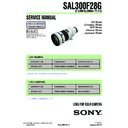Sony SAL300F28G Service Manual ▷ View online
5-21
SAL300F28G (2.8/300 G) (300mm F2.8 G)
2. Checking Method
1)
Turn the focus ring of the checking lens until the chart image projected on the screen is the sharpest at the center (y’=0).
2)
Read the number of the smallest pitched lines at the center (y’= 0).
Fig.5-3-3
3)
Turn the mount rotation ring of lens test projector until the projected image at a certain peripheral point (y’= 15 or 18) on the screen
appears the most unsharp.
Read the number of the smallest pitched lines (both saggital and meridional: 3 lines) at the peripheral point.
Note:
When reading the number of the smallest pitched lines, be careful of the spurious resolution.
Spurious resolution is the reversed image of 2 or 4 lines which appears on screen when focus is beyond maximum revolving
power.
Do not confuse spurious resolution for the smallest pitched lines.
Fig.5-3-4
4)
Check that the all readings (y’= 0, saggital (S) and meridional (M) at y’= 15 or 18) at focal-length and distance is within the
specification of the Table 5-3-2.
Specification
Focal-length distance (m)
Number of the smallest pitched lines
f (mm)
Center (y’=0)
y’= 15 (Lines per mm)
y’= 18 (Lines per mm)
(Lines per mm)
S
M
S
M
300
12.08
160 or greater
63 or greater
63 or greater
63 or greater
50 or greater
Table 5-3-2
The number represents for lines per mm.
Saggital (S)
Meridional (M)
Correct resolution
Spurious resolution
5-22
SAL300F28G (2.8/300 G) (300mm F2.8 G)
5-4.
OPTICAL AXIS/FLANGE BACK (f’F) CHECK/ADJUSTMENT
5-4-1. Optical Axis Check/Adjustment/Flange Back (f’F) Check
Equipment
• 1000 mm Collimator
• Flange Back Tester
• A-mount Attachment
• Flange Back Gauge (43.50mm)
1. Preparations
1)
Set the equipments as shown in the Fig.5-4-1.
Fig.5-4-1
2)
Looking through the eyepiece lens, turn the eyepiece ring of the flange back tester so that cross line or scale in the view is the sharpest.
3)
Attach the flange back gauge (43.50mm) securely to the A-mount attachment and hold them together.
4)
Turn the focusing knob of the flange back tester so that fine scratches on the flange back gauge (43.50mm) is the sharpest.
Note:
Turn the knob in the direction of the arrow of Fig.5-4-2 for correct reading.
Fig.5-4-2
5)
Turn the scale ring of the dial gauge until the long pointer indicates “0”.
Note:
This position is the flange back (f’F) = 43.50 mm.
Memorize the position of short-pointer.
flange back gauge (43.50mm)
A-mount attachment
Objective lens (10x)
Dial Gauge (Min. scale: 0.01 mm)
Scale ring
Eyepiece lens (7x)
Eyepiece ring
Focusing knob
Focus on fine lines on the surface.
Always turn the knob in the arrow
direction for correct reading.
direction for correct reading.
5-23
SAL300F28G (2.8/300 G) (300mm F2.8 G)
2. Optical Axis Check
1)
Attach the checking lens to the flange back tester, and set the 1000 mm collimator.
Fig.5-4-3
2)
Set the focus ring of the checking lens to infinity end position while looking through the microscope, and align the optical axis to the
center of the chart image accurately.
3)
Turn the focusing knob of the tester until the chart image is the sharpest (red and green color areas are equal on the chart *).
*: Position in which the color of collimator chart changes from green into red and come into focus.
Also check the optical axis aligns with the chart center. (Refer to Fig.5-4-4.)
Note:
Figure shows example. The cause depends on individual lens.
Fig.5-4-4
4) Check that the specification of the Table 5-4-1 is satisfied.
CB
Phenomenon that seems that color (flared) remains in one direction of ring chart at the best focus.
AS
Phenomenon that seems that color of ring chart divides into direction of cross at the best focus.
Fig.5-4-5
Specification
CB
0.09mm or less
AS
0.05mm or less
Table.5-4-1
5) When the CB and AS of the checking lens meet the specification of the Table 5-3-1, perform the “3. Flange Back (f’F) Check”.
1000 mm collimator
Checking lens
Optical Alignment
Best alignment
Best alignment
Incorrect aligned
e.g. As the focusing knob is turned, the chart may appear blurry as illustrated.
The cause depends on individual lens.
e.g. As the focusing knob is turned, the chart may appear blurry as illustrated.
The cause depends on individual lens.
CB
AS
5-24
SAL300F28G (2.8/300 G) (300mm F2.8 G)
3. Flange Back (f'F) Check
1)
Set the focus of lens to be measured to around the infinity.
2)
Confirm the flange back (f'F) value.
Flange back (f'F) value of measured lens = (Value of flange back gauge) + (Number of rotation of short pointer) +
(scale of long pointer)
Specification
Focal Distance f(mm) Flange back value f'F(mm)
Flange back value f'F(mm)
Over-infinity (around the infinity)
Optical infinity (L index)
Difference from over-infinity
Difference from over-infinity
300
46.97
± 0.15 (46.82 to 47.12)
-2.41
Table 5-4-2
3)
Rotate the knob of microscope and set the dial gauge to the value below.
Measured flange back value (f'F) at the over-infinity -2.41mm
4)
Rotate the mirror tube block so that it is in focus.
Note:
Confirm that L index is in the range shown below.
Fig.5-4-6
Click on the first or last page to see other SAL300F28G service manuals if exist.

